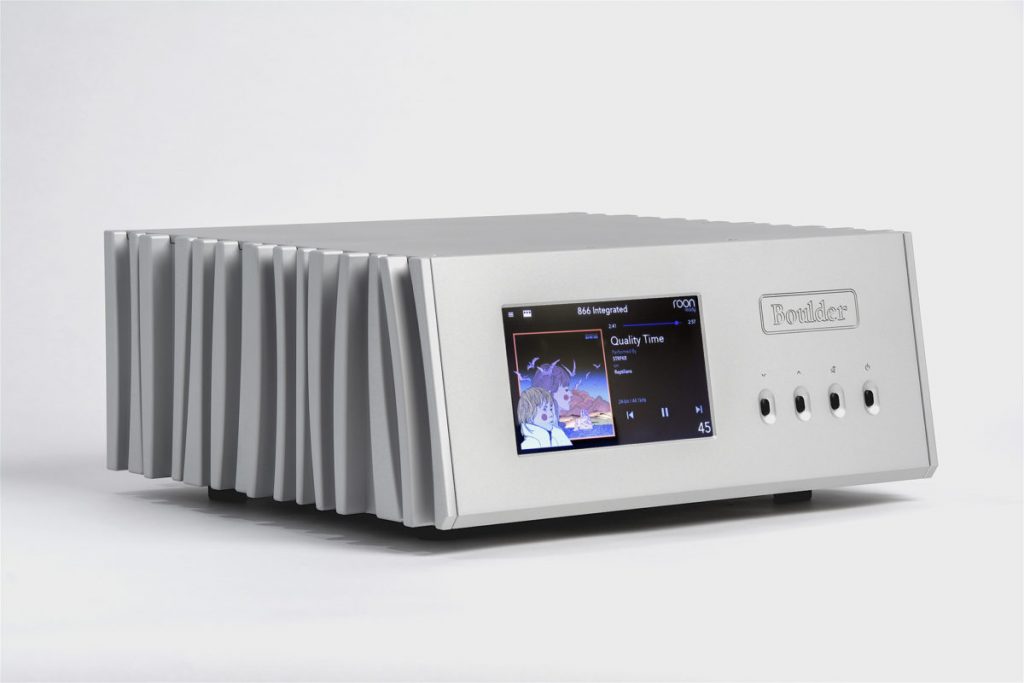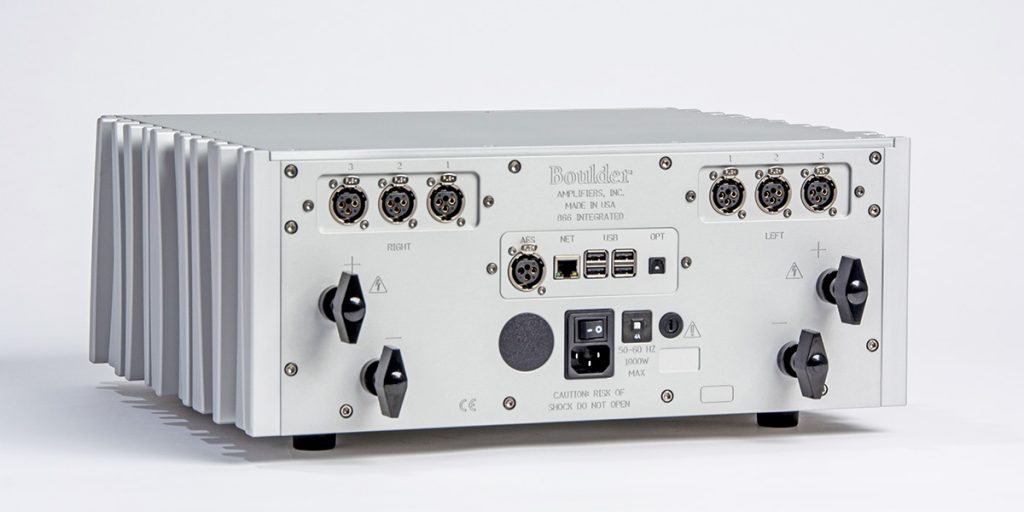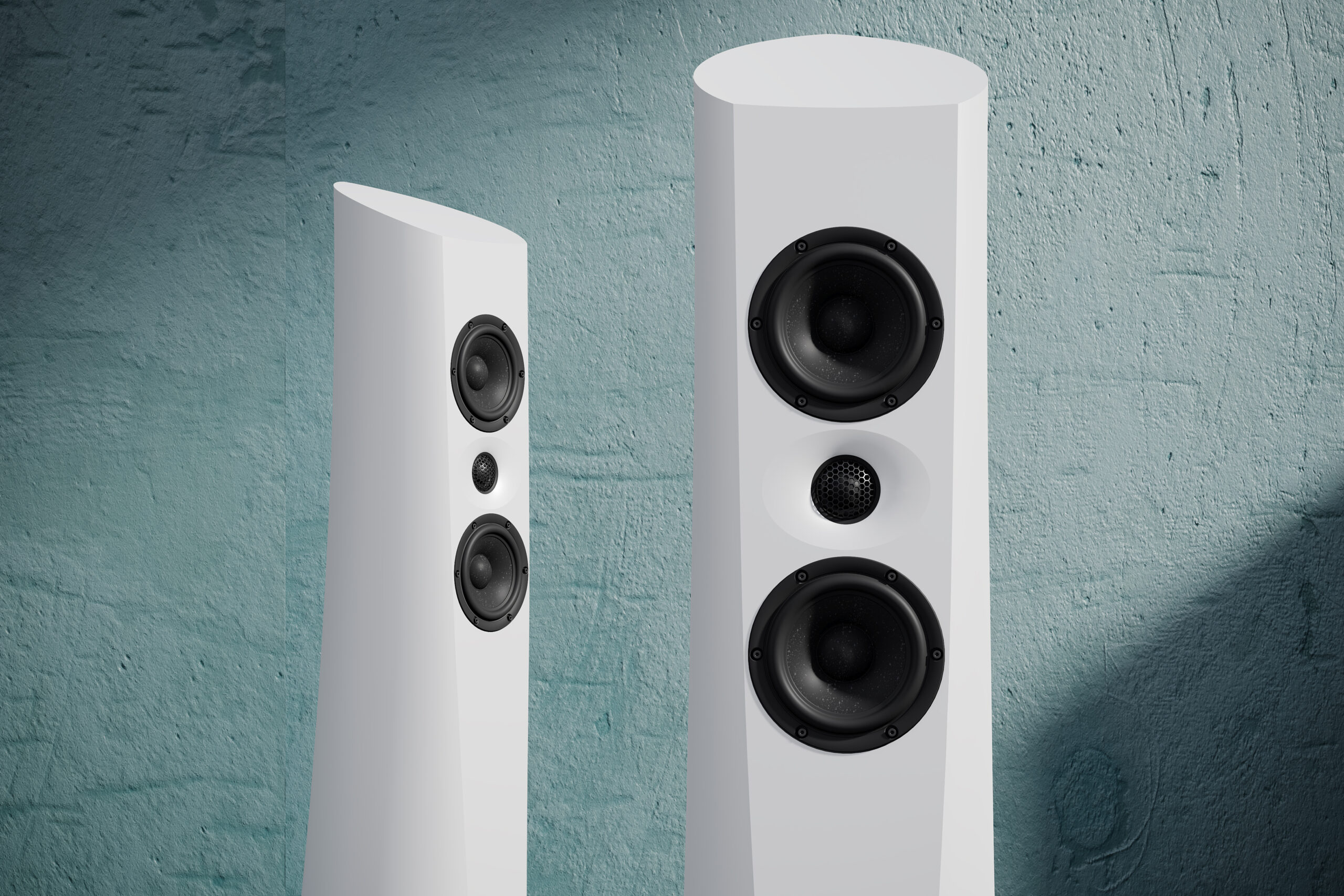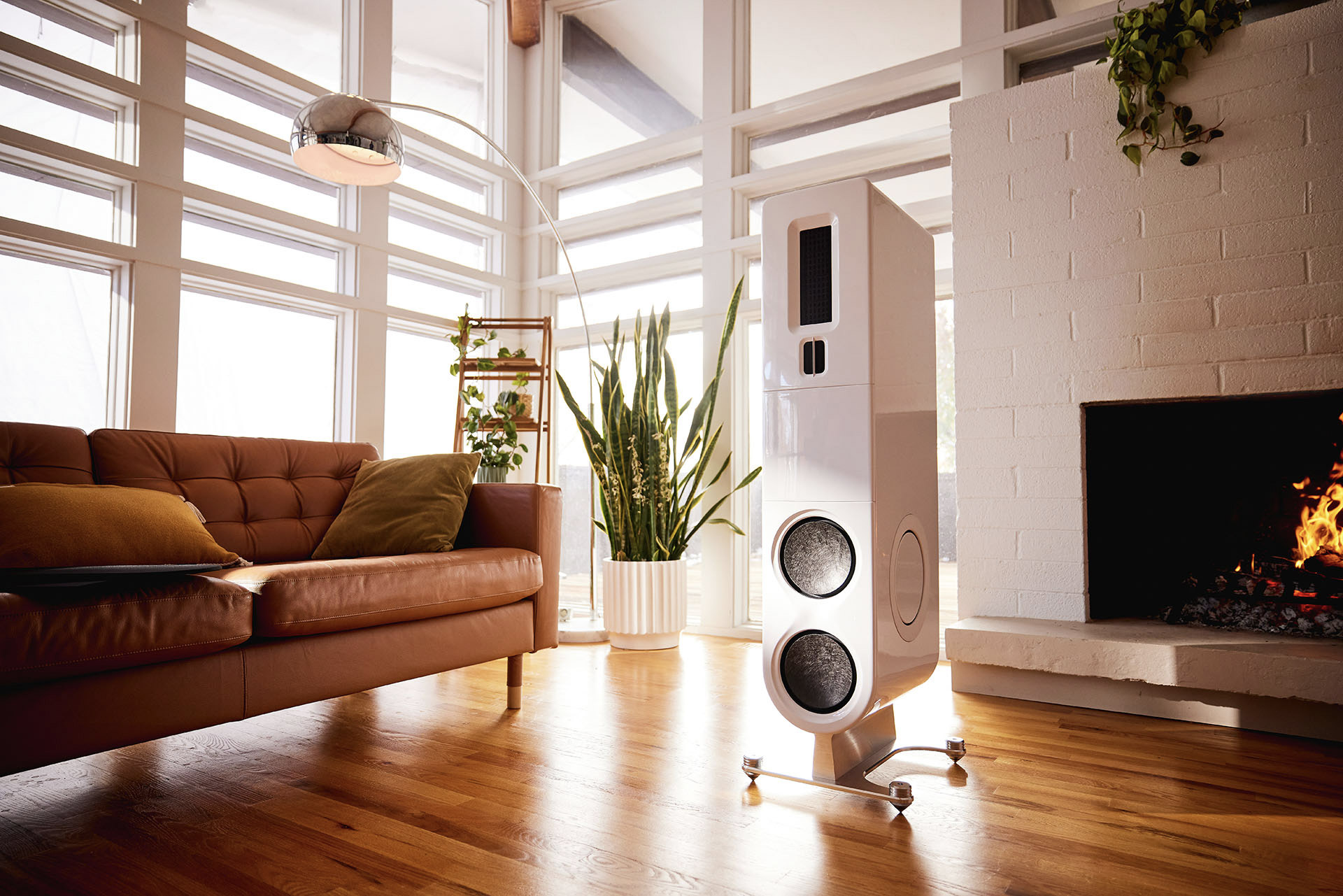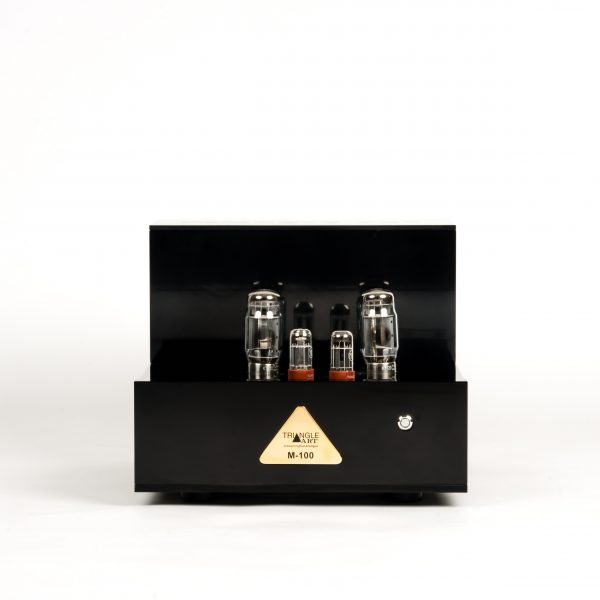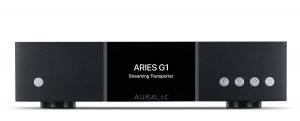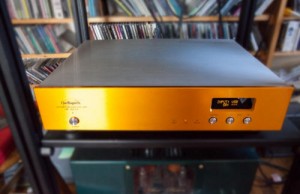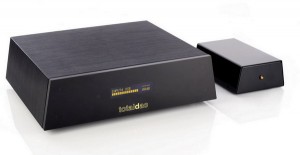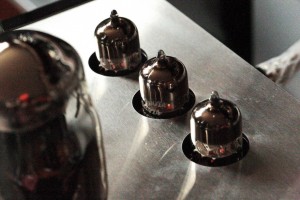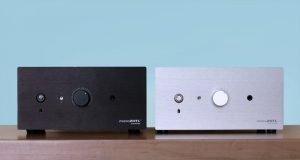I recently reviewed the entry level Boulder 508 phono stage, and it surprised the boots off me by its price / performance ratio. It's so good, in fact, that it ended up finding a permanent spot in my system. Since then I have been following the roll out of Boulder's latest product, the 866 integrated amplifier DAC/streamer, with a keen eye.
I was offered a shot at the Boulder 866 as it would accompany another product offered for review, the Chario Sonnet monitor speaker from Italy via Rich Maez and Monarch Systems LTD. Boy did I luck out on both counts.
My love for integrated amplifiers goes back to the first integrated I ever reviewed—the Mechanical Research Corporations Niro1000. A design by famed Japanese designer Niro Nakamichi, yes, that Nakamichi. I curse the day I turned down the chance to buy that wonderful amplifier. Since the Niro, I have auditioned, or formally reviewed, several integrated amplifiers from the likes of Krell, most recently the K300i, one from Analog Domain, two from Gryphon Audio, the Diablo 120 and the Diablo 300, and the priciest of the bunch, the Dan D'Agostino Integrated which I owned for a couple years.
With each experience, my reasoning for maintaining the cost, complexity, and space requirements of separates has been chipped away, slowly but surely. I'm not naive however. I'm not suggesting the integrated offerings are better than the grander separates from any of these companies. I have enjoyed some the greatest audio separates money can buy—I know what's possible. I have stuck with separates for practical reviewing logistics, for obvious reasons. I did go down the integrated road with the Dan D'Agostino Momentum a few years ago, but I had to reverse course due to some reliability issues.
I have again been craving simplicity, tidy-ness, and a family friendly accessibility while maintaining high performance. Integrateds also clean up the system while lowering the overall cost with fewer power cords and interconnects to buy. As hard as I try, I always fail miserably trying to hide the tangle of wires that come with complex systems. This is more of an issue for me, as my listening room doubles as our family's entertainment and living area in our loft.
The 866 features the same durable satin finish aluminum found on my 508 phono stage, and they look very nice side by side. The build quality is duly commensurate with the price, and is solid as a rock. The 866 features a large touch screen that took a few touches in order to get the feel for its responsiveness. All functions are available for set up on the sub menus via the touch screen. Each input can be loaded with any image you may choose to represent the input on the touch screen. To the right of the screen there are hard buttons; a volume down button, volume up button, mute, and power standby. The Boulder operation app is available for download, and a must for streaming, but also mimics all the front panel operations. There is an all analog 866 ($12,250) and the digital equipped and Roon enabled ($14,450) version reviewed here. Why one would opt for the all analog version is a bit of a mystery to me, but I'd imagine there are those married to their present digital separates, or no interest in digital at all.
The 866 offers 200W of maximum output power into an 8-ohm load, with a new protection scheme that allows for greater and safer current output and peak power delivery. The 866 allows factory direct software updates by Ethernet or USB memory device.
Features of the analog+digital version include three pairs of balanced inputs and one RCA analog input. There are Toslink, S/PDIF, Ethernet, and USB digital input capabilities. Apart from the Boulder app for Apple and Android mobile devices, there is currently no Apple AirPlay wireless streaming capability. The built-in server software support connection to media storage devices over USB or Ethernet, with UPnP/DLNA wired and wireless streaming over Ethernet.
The 866 takes the basic box and gives it a few twists. For one, the front panel is angled back 10-15 or so degrees. It really does function to offer a better view at the front screen and buttons. The heat sinks along the sides echo a series of Richard Serra sculptures turned on their ends.
To be honest, I'm not crazy about the idea of touch screens on audio gear, and this is the first time I have lived with one. Through the menu options I was able to diminish the brightness down to a more comfortable level. I would have liked a screen defeat option that did not require scrolling through the menus. But it's only a few touches away, allowing the user to dim the screen to nearly complete black out. The ability to assign your own images, say a picture of your turntable for instance, to an input is a very cool option. In total, the functionality of the 866 is fantastic.
The thing that struck me on first listen, and the quality from which all the other strengths seem to spring, is the sheer transparency and articulation of the 866. That's two actually, three if you cast them under the umbrella of neutrality. The 866 is capable of world class effortless rendition of detail and ultra clean transient speed. A dead silent atmosphere holds copious volumes of space. All of this information allows you to listen very deeply into a recording. Aaron Neville's "Feels Like Rain" has a slight trail of echo on Aaron's voice that is laid more bare than usual, lasting longer as it disappears into the silence. There is more air around, and space between the images. Eric Clapton's Unplugged shows just how deep into the recording one can see. Not only are all the individual musical lines distinct, you can hear and feel that percussive nature of even non percussive instruments. That moment when two opposing forces come together creating musical sound, beautifully rendered.
"Lonely Stranger" is perhaps one of the most deeply personal, soul revealing, and beautiful songs ever written. This song captures something in me, it's touching in a darkly romantic way. I cry every time I hear it. The 866 did not disappoint delivering the essential emotional content through startling sonic clarity. With this clarity comes an authenticity to texture, timbre, and insight into not only this recording but all other recordings I played through the 866. The 866 turns each recording into a thrilling journey, even my well worn favorites.
Two hundred watts into 8 ohms doubles down to 400 into 4 ohms. But the 866 expresses the lower registers in a cleaner more transparent way, if not quite as weighty as the separates. When I felt like punishing the neighbors, "I'm Home Africa," from Stanley Clarke's East River Drive through my Sunny Majestic 15 speakers that are capable of jet engine level bass thrust. Even at full throttle the 866 never flamed out on me. There was outstanding bass detail, super clean bass transients, and a focus to the shape of some of the most powerful bass ever recorded. The 866 lets you know exactly when the note starts and when it stops. Added to the outstanding control, the texture and color of low end bass notes goes hand in hand with the overall transparency and detail. "What If I Forget the Champagne" from the same album features a low bass supporting a bass line an octave higher. The low bass is so clearly audible, its starts, stops, tone, and dynamics are just amazing. The Pass Labs monster monos do provide a denser, bolder presentation, but are also a bit more opaque.
I found I could endlessly turn up the volume level without a hint of the 866 loosing its grip on the bass, or squashing the separate instrumental lines into a mush. I can't emphasize this enough, the 866 is a monster at controlling the signal at both the loudest or softest volumes. Mind you, my room is 36' x 60' x 14' and my Sunny Cable loudspeakers are 500 lbs a side and 6 ft tall. The 866 simply crushed the ball and went upper deck. Despite the Sunny's relative efficiency, they really respond to power. As the volume reached my physical and psychological limits, I was staring at the 866 waiting for it to literally explode into a million pieces, yet no such fate would befall it. To my great relief the 866's robust protection circuitry did not fail.
There is a directness, a connection to the music, and seeming total absence of coloration or distortion imparted by the 866. Giving the analog circuitry a run, I hooked up the the great VPI Avenger Reference through the Boulder 508 phono stage. The 866 via the amazing Cardas Clear Beyond cables, showed life, verve, and body to the sound, along with that undeniable analog ease. Even albums like Black Sabbath's Neon Knights benefited mightily. Playing the title track was so musical, yet not lacking a bit for pace or drive. The separation of the recorded elements, despite the patched together engineering, came across unadulterated and very well balanced. The late Ronny James Dio delivers some of the best metal vocals ever recorded. I love this entire record, and that's exactly what I listened to, the entire record.
All vocals are as clean from distortions and tonal shifts as I've ever heard. From Willie Nelson signing "Funny How Time Flies" to Dwight Yokum's melancholy tale of a family breaking apart and moving on, "Home for Sale," you intuitively understand the 866 is imparting no signature. Dwight's twang can be edgy if there is some edge imparted by the system. Through the 866 that edge is simply a part of his expression and the nature of his voice.
Vocals through the 866 can be light and airy when called for, deep and resonant when on the recording. Johnny Hartman singing another one of my favorite songs, the wistful "Lush life" from his album with John Coltrane is just that perfect convergence, where superb sonics and vocal artistry merge beautifully. This is a vocal master class all on its own, a tour de force of vocal perfection. And when Coltrane jumps in mid-song, the blast of his horn has zero unnatural edge or glare. It just sounds like the engineer leaned on the horn's volume pot a little, glorious stuff. Reading about this is one thing, hearing it is another mile down the road to understanding just how neutral the 866 is.
For some more acoustic music, Red Garland's Bright and Breezy is one of my all time favorite records. I grew up listening to this recording as my father continued to study every nuance of his late mentor's touch. "On Green Dolphin Street," a song my father would play for me every year on my birthday whether I was near or far, has never sounded bad to me, whether played on a mega system or a clock radio. This is a song I have a very deep emotional connection with. Through the Boulder 866, the piano and surrounding bass and drums seem to occupy more space. The atmosphere is less vacuous. The 866 sounds lithe and nuanced, with each note so distinct and clear. Micro and macro dynamics of the drums is outstanding. The timbral shading gracing Red's touch reveals that musical insight so important in conveying the feeling, the heart, and the soul of his playing.
When reviewing the outstanding Chario Sonnet monitors, the 866 was instrumental in getting the best from them. For 22K, this combo offers a heap of the best the High End has to offer. What became clear through the aluminum vapor coated soft dome tweeter of the Chario was that the 866 resolved the finest treble detail with grace and ease. Cymbals and snares, whether struck or grazed with a brush, as on Tommy Flanagans' "Sea Changes," there is zero distortion filling the minuscule spaces between the complex resonance of micro timbers exited by the wires of the brushes. The warmth of the Chario is a wonderful foil for the 866's unflinching sonic honesty.
Having been cooped up through the Covid-19 quarantine, I decided to pull out my dusty CD cases and look them over. I have a Proceed CDP CD player/transport from the late eighties, and I connected it to the digital XLR input of 866. First up was San Francisco Days from Chris Issak. I really was shocked at how good the sound was. "Can't Do a Thing" was awash in space, and Chris's voice had incredible presence and detail. I knew from there it would all be gravy. All of my CDs have now been cleaned and alphabetized, and I am really digging rediscovering the format. Like rediscovering analog from my childhood, CDs represent my early adulthood and entrée into High End audio. The 866 has helped to tap into that very nostalgic time in my life and expanded my joy of music. I guess what I'm getting at is the 866 will breathe life into this often maligned and underestimated format via its outstanding DAC.
Compared to the 75K worth of separates I use, the only thing I can say the 866 may not quite equal the duo in is density of image, sheer presence, and overall richness. To put that into perspective, richness and body have always been very important to me. What I'm getting from the Boulder's strengths, its take on the music is so compelling on its own terms, I'm just not missing what's not there. The 866 succeeds wildly on its own merits.
The Boulder 866 makes an incredibly compelling overall case. I had a feeling it would be good, but not this good. Like the surprise delivered by Boulder's diminutive 508 phono stage, I was not prepared for how good the 866 would be, and to an even greater degree than the surprise delivered by the 508. No matter how you cut it this integrated amplifier DAC/streamer is a triumph of audio design and engineering. Do not skip over this piece if you are shopping any where near the price. And please, do not let the relatively compact stature fool you—this thing is a beast. It is truly cutting edge in sonics, capabilities, and construction. In 25 years of sampling audio gear, the Boulder 866 is one of the best audio components I've ever reviewed.
866 Integrated
Retail: $12,250 (analog) or $14,450 (digital equipped and Roon enabled)
Boulder




